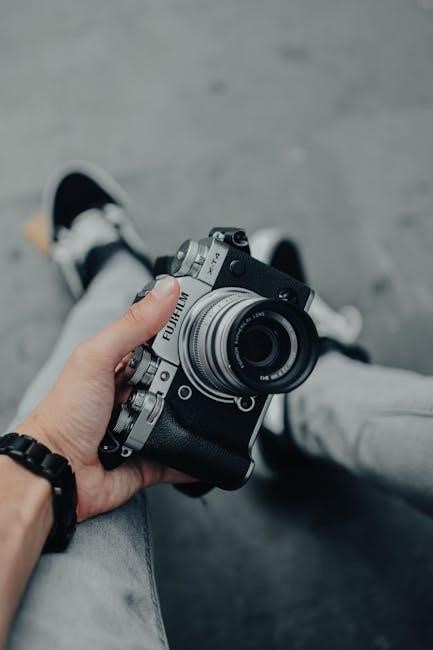
nikon d60 instruction manual
Welcome to the Nikon D60 Instruction Manual, your comprehensive guide to mastering the camera’s features. This manual covers camera controls, shooting modes, menu navigation, and maintenance tips, ensuring optimal photography results for both beginners and advanced users.
Overview of the Nikon D60 Camera
The Nikon D60 is a high-performance digital single-lens reflex (D-SLR) camera designed for both novice and advanced photographers. Featuring a 6.3-megapixel CMOS sensor and Nikon’s EXPEED image processing engine, it delivers crisp, vibrant images. The camera is lightweight and compact, making it portable for everyday use. With a user-friendly interface and advanced features like 3D Color Matrix Metering II and an 11-area autofocus system, the D60 offers versatility for capturing stunning photos. Its ISO sensitivity range (100-1600) and in-camera image editing options further enhance its functionality, ensuring a seamless photography experience.
Importance of Reading the Instruction Manual
Importance of Reading the Instruction Manual
Reading the Nikon D60 instruction manual is essential to unlock its full potential. It provides detailed explanations of camera functions, shooting modes, and customization options, enabling users to make the most of their photography experience. The manual also covers troubleshooting, maintenance, and best practices, ensuring optimal performance and longevity of the camera. By understanding the camera’s features and settings, users can enhance their creativity and technical skills, capturing high-quality images with confidence and precision.

Camera Controls and Layout
The Nikon D60 features an intuitive design with strategically placed buttons, dials, and compartments. Understanding the camera’s controls is key to navigating and optimizing its settings effectively.
Top Controls: Mode Dial, Shutter Release, and Command Dial
The Nikon D60’s top controls include the Mode Dial, Shutter Release Button, and Command Dial. The Mode Dial offers settings like Auto, P, S, A, and M modes. The Shutter Release Button, located on the grip, captures images with a gentle press. The Command Dial adjusts settings like aperture, shutter speed, or exposure compensation. These controls provide quick access to essential functions, enabling photographers to customize their shooting experience. Understanding their placement and operation enhances your ability to capture stunning images efficiently.
Rear Controls: Multi-Selector, Playback, and Menu Buttons
The rear of the Nikon D60 features essential controls for navigation and operation. The Multi-Selector allows easy menu navigation and image selection during playback. The Playback Button lets you review captured photos, while the Menu Button provides access to various camera settings. These controls are intuitively designed for quick access, enabling efficient adjustment of camera functions and enhancing your overall shooting experience.

Understanding the Lens and Memory Card Compartment
The Nikon D60’s lens and memory card compartment are crucial for capturing high-quality images. The lens mounts securely using the F-mount system, ensuring compatibility with a wide range of Nikon lenses. The memory card compartment, located on the right side, supports SD and SDHC cards. Properly inserting the memory card ensures your photos are saved. Always handle the lens with care to avoid scratches and clean it regularly for optimal performance. Use compatible memory cards to ensure smooth data storage and retrieval during your photography sessions.

Navigating the Menu System
Navigate the Nikon D60’s menu system using the Multi-Selector and OK button. Access Playback, Shooting, and Setup Menus to customize settings and enhance your photography experience.
Playback Menu: Reviewing and Managing Photos

The Playback Menu allows you to review and manage your photos conveniently. Use the Multi-Selector to scroll through images, delete unwanted photos, or protect them from deletion. You can also create slide shows, set image rotation, and hide or display histograms for exposure review. Additionally, the menu offers options to print photos using Nikon’s PictBridge feature or transfer images to a computer via USB. These features make organizing and sharing your photos straightforward and efficient, ensuring your memories are preserved and easily accessible.
Shooting Menu: Customizing Camera Settings
The Shooting Menu provides options to customize camera settings for optimal photography. Adjust autofocus mode, metering, and ISO sensitivity to suit your scene. White balance settings can be fine-tuned for accurate color representation. Additionally, you can enable or disable features like noise reduction and long exposure noise reduction. These settings allow you to tailor the camera’s performance to your creative vision, ensuring high-quality results in various lighting conditions. Experiment with these options to enhance your photography experience and achieve the desired effects in your images.
Setup Menu: Adjusting Camera Preferences
The Setup Menu allows you to customize camera preferences for a personalized experience. Adjust monitor brightness, set the camera’s language, and enable or disable features like image review and auto information display. Format memory cards, set date and time, and configure system language. You can also customize the camera’s auto-off timing and LCD illumination. Additionally, this menu provides options for firmware updates and resetting the camera to factory settings. These adjustments ensure your Nikon D60 is tailored to your preferences and shooting style, enhancing workflow efficiency and camera performance.

Shooting Modes and Exposure Control
The Nikon D60 offers various shooting modes and exposure controls, including Auto, Manual, and modes for adjusting aperture, shutter speed, and ISO, enabling precise photography results.
Auto Mode: Point-and-Shoot Photography
The Nikon D60’s Auto Mode is designed for effortless photography, ideal for beginners. It automatically adjusts exposure, focus, and ISO for optimal results. With the camera handling settings, users can focus solely on composition. The built-in flash and scene modes further enhance image quality in various lighting conditions. This mode is perfect for casual outings, ensuring sharp and vibrant photos without manual adjustments. It simplifies the photography process, making it accessible for those new to DSLR cameras. Auto Mode is a reliable choice for quick and spontaneous shooting scenarios.

Manual Mode: Advanced Control for Professional Results
Manual Mode on the Nikon D60 offers complete creative control, allowing photographers to adjust aperture, shutter speed, and ISO independently. This mode is ideal for professionals seeking precise control over exposure and artistic expression. Users can fine-tune settings to achieve desired effects, such as depth of field or motion capture. The camera’s metering system provides guidance, but ultimate control rests with the photographer. Manual Mode is perfect for those familiar with photography fundamentals, enabling them to unlock the camera’s full potential and produce exceptional, customized results in various lighting conditions.
Understanding Aperture, Shutter Speed, and ISO
Aperture, shutter speed, and ISO are fundamental exposure controls in the Nikon D60. Aperture regulates light entry through the lens, with lower f-stops (e.g., f/2.8) opening wider for more light and shallower depth of field. Shutter speed controls exposure duration, with faster speeds (e.g., 1/1000th of a second) freezing motion and slower speeds creating blur. ISO adjusts sensor sensitivity, with lower values (e.g., ISO 100) suited for bright light and higher values (e.g., ISO 6400) for low-light conditions. Balancing these elements ensures optimal exposure and creative control in various lighting scenarios.

Troubleshooting and Maintenance
This section provides solutions to common issues and maintenance tips to keep your Nikon D60 functioning optimally. Learn to clean the sensor, manage battery life, and resolve errors effectively.
Common Issues and Solutions
Addressing common issues with your Nikon D60 ensures uninterrupted photography. If the camera won’t turn on, check the battery or power connector. For blurry images, clean the lens and sensor. If the memory card is not recognized, format it in the camera. Errors like “CARD FULL” indicate insufficient storage. For focusing issues, ensure autofocus is enabled and the lens is clean. Consult the manual for specific error codes and troubleshooting steps to resolve problems efficiently and maintain peak performance.
Cleaning the Sensor and Lens

Regular cleaning of the sensor and lens is essential for maintaining image quality. Use a soft, dry cloth to wipe the lens, avoiding harsh chemicals. For the sensor, activate the camera’s cleaning mode or use a blower to remove dust. Avoid touching the sensor surface. If smudges persist, refer to the manual for guidance on manual cleaning. Always handle the camera with care to prevent damage and ensure optimal performance for your Nikon D60.
Battery and Memory Card Maintenance
Proper care of the battery and memory cards ensures reliable performance. Charge the battery using the provided charger, avoiding extreme temperatures. For memory cards, format them in the camera before use to prevent data errors. Use high-speed cards for optimal performance. Avoid removing the card during write operations. Store cards in protective cases and handle them by the edges to prevent static damage. Regularly clean the card contacts with a soft cloth. Replace the battery if it no longer holds a charge, and always use Nikon-approved accessories for compatibility and safety.